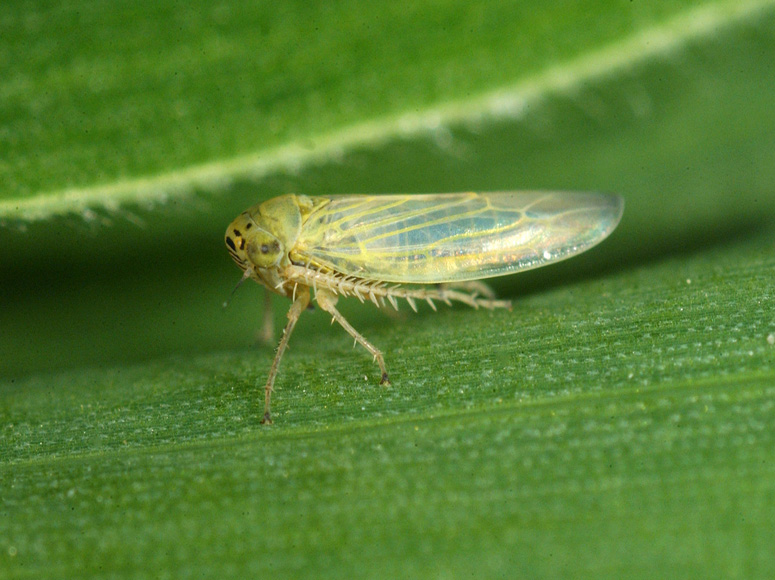
Agricultural News
A Dry Fall Means "Plant Vampires" in Wheat and Canola
Tue, 25 Oct 2011 13:41:56 CDT
 A hot, dry summer like we have experienced can drive many plant feeding insects to look for any green, succulent plants to snack on until they die or hibernate for the winter. We are getting reports of leafhoppers attacking winter wheat. Several leafhopper species will move into, and feed on wheat, including the painted leafhopper, the aster leafhopper and the gray lawn leafhopper, just to name a few. These insects are small (1/16 - 1/8 inches) wedge-shaped relatives of aphids that actively fly and move when disturbed. The gray lawn leafhopper is grayish-yellow with dark brown markings and two black spots on its "face". The aster leafhopper is greenish yellow with 3 pairs of spots or dashes on its "face".
A hot, dry summer like we have experienced can drive many plant feeding insects to look for any green, succulent plants to snack on until they die or hibernate for the winter. We are getting reports of leafhoppers attacking winter wheat. Several leafhopper species will move into, and feed on wheat, including the painted leafhopper, the aster leafhopper and the gray lawn leafhopper, just to name a few. These insects are small (1/16 - 1/8 inches) wedge-shaped relatives of aphids that actively fly and move when disturbed. The gray lawn leafhopper is grayish-yellow with dark brown markings and two black spots on its "face". The aster leafhopper is greenish yellow with 3 pairs of spots or dashes on its "face".
These "plant vampires" feed on the wheat plant's sap with their needle-like mouthparts, and literally suck the life out it. Symptoms of leafhopper damage in wheat are similar to symptoms of nitrogen deficiency. Leaf blades may turn brown along the edges and have a green-yellow color to the leaves. One question that sometimes arises about leafhoppers in wheat is "do they transmit barley yellow dwarf virus?" The short answer, based on years of research by numerous entomologists and plant virologists, is NO! Any correlation between treating a wheat field with an insecticide for leafhoppers and a seeming reduction in barley yellow dwarf incidence probably occurred because infective aphids were controlled as well.
What about canola? Well, the aster leafhopper (also known as the six-spotted leafhopper) is of concern because it is a vector of aster yellows. Aster yellows disease is caused by a mycoplasma that requires transmission by a host insect. This disease can be particularly damaging to canola, especially when it infects plants early. It affects more than 300 plant species including several common weeds such as horseweed, plantain, ragweed, wild carrot and wild lettuce.
The leafhopper picks up the disease as it feeds, but it takes 9 to 21 days for it to become infective. Infective asters leafhoppers can spread the disease for up to 100 days. Aster yellows disease is difficult to control but growers should not panic about asters leafhoppers and this disease. Typically, aster yellows infects 2-5% of plants in a given field with the occasional exception.
Control: Research conducted in snap beans and okra suggests that Gaucho or Cruiser should be effective at warding off early leafhopper infestations in canola and wheat for up to 30 days. I know of no recommended treatment threshold for leafhoppers; in fact I found only one reference on leafhoppers in wheat, written in 1932. My "rule of thumb" suggestion for controlling leafhoppers in wheat or canola is that if noticeable symptoms of damage are present and leafhopper numbers are high (they come up in clouds as you walk) consider treatment with an insecticide. In wheat, Lorsban 4E SG and dimethoate are specifically labeled for control of leafhoppers, but other products such as Baythroid, Karate, Mustang MAX and Proaxis will likely work as well. For canola, Brigade, Mustang MAX, Proaxis or Warrior are registered for use and should provide control. Leafhoppers will probably be around until things really cool down, sometime in November.
For specific information, consult Current Report CR-7194 Management of Insect and Mite Pests in Small Grains and Current Report CR-7667 Management of Insect and Mite Pests in Canola.
Our thanks to Dr. Tom Royer, Oklahoma State University Extension Entomologist for this article over insects attacking winter wheat. This article was part of the Department of Plant and Soil Sciences Extension News Newsletter.
WebReadyTM Powered by WireReady® NSI
Top Agricultural News
More Headlines...



















